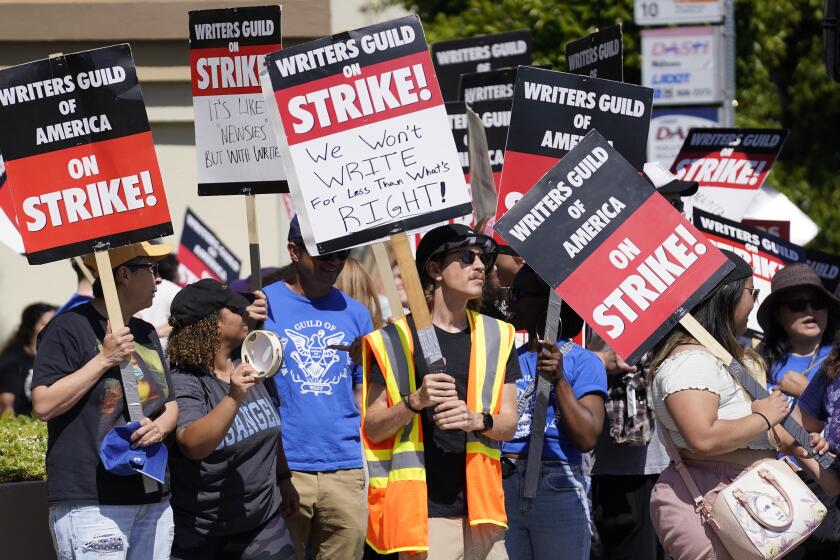Refugee Finds Solace in His Art : Exhibition: Viet Nguyen shows traces of suffering in his recent prints.
- Share via
Artist and gallery owner Viet Nguyen is tired of Americans feeling sorry about his past.
“That is always the first thing people say when they meet me and find out I am from Vietnam,” said the soft-spoken Nguyen as he sat on the floor of his gallery in Burbank, surrounded by some of his recent prints. “Always, they say, ‘I am so sorry about what happened to your country. I am so sorry about what happened to you.’ ”
A lot did happen to Nguyen, who was in the Vietnamese navy during the war and escaped Saigon just hours before the city fell in 1975. He endured terrible suffering as one of the boat people set adrift in the aftermath of the war and later that year when his difficult transition to a new culture in Los Angeles brought him to the brink of suicide.
Traces of those dark days can be found in the mixed media artworks in his first solo exhibition, now on display at the McGroarty Arts Center in Tujunga. But Nguyen, who said he has made an uneasy peace with his past, wants his abstract works to evoke the beauty of the country he left behind.
“It is my goal that when we talk about Vietnam, it is not just the war, always the war, that we talk about,” Nguyen said in his accented but almost flawless English. “Vietnam was a very pretty country, with a great culture, great art. I think we have something to bring to the American culture.”
Nguyen, 39, was born in Saigon to a cosmopolitan family. His father was an interior designer who did a great deal of work for Prince Norodom Sihanouk when the prince ruled Cambodia (now Kampuchea). From an early age, Nguyen had an interest in art. He helped his father in the decorating business and later enrolled in the National Fine Arts Center.
In the navy he worked with a propaganda unit that tried to win over the hearts and minds of villagers to the government cause. The unit met with mixed success, at best, and sometimes found itself in the line of fire. One day Nguyen and his colleagues were approaching a man who seemed to be a farmer working in a field with two women and three children. Suddenly, without warning, the man picked up a hidden machine gun and began spraying the unit with bullets.
“I jump around, and he missed me, I don’t know how,” Nguyen said, jumping to his feet to demonstrate how he danced around to try and avoid the bullets. Members of his unit returned the fire--two of the women and one of the children were killed and the man, who was stationed there to protect a nearby Viet Cong hospital, was captured. Two of Nguyen’s colleagues were killed and an American assigned to the unit was critically injured.
“What I saw was unbelievable,” he said.
On April 30, 1975, the day Saigon fell, Nguyen had the job of destroying his unit’s records. He was just about to set them afire when his captain burst into the room to say that the time had come to escape. They made it down to the harbor and eventually got onto a boat that was headed out to open sea. The boat was built to handle a few hundred people, Nguyen said, but by the time it left Saigon he estimates it was carrying 5,000.
“The worst thing was the children that died,” Nguyen said. “I could do nothing. None of us could. Conditions were terrible and there was no medicine.”
It took two weeks for the boat to make it to the Philippines. Nguyen spent time in a refugee camp on Guam and then in Camp Pendleton until a church group got him an apartment and a job as a picture framer in Northridge. But his troubles were far from over.
“I had no one here, no relative, no friend,” said Nguyen, who had left his parents, two brothers and a sister behind. He worked long hours, and when he was home alone he drank heavily. “If I did not drink, the past would come back to me. I did not see a future.” He contemplated suicide.
Nguyen doesn’t know why, but about 1 1/2 years after he arrived in the United States he suddenly woke up one morning and decided he had to get on with his life. He stopped drinking and enrolled in an art class at Los Angeles Valley College. In 1977, with a partner, he had enough money to open the Studio Gallery in Burbank.
Supported by a framing shop he operated in the back, the gallery hosted exhibitions by local artists, including one that showed works of Nguyen and four other Vietnamese artists.
His early prints and paintings had a somber look and melancholy subject matter. One large drawing, titled “Past Reflections,” was of men sitting on rocky cliffs, looking out into the horizon. Nguyen pointed out that into the drawing of the cliffs he had worked stylized representations of bodies, broken apart and in agony.
As he continued his classes at various local schools, his works got more abstract. Many featured blocks of color, set off by sharp lines, in geometric patterns that are imagined landscapes as seen from above.
“When I was in the navy I went in a plane for the first time, from Cam Ranh Bay to Saigon,” he said. “I see many things looking down at the ground and it made a impression on me. I want to capture what I see.”
It is these imagined, aerial-view landscapes and mixed media pieces that combine etching, embossing and even neon that are featured in the McGroarty show. They are all abstracts but nearly all have at least one motif that looks Asian. On some, he simply pastes a small, irregular swatch of gold or silver leaf. “It is the kind of material used in Oriental art,” he said.
“My home is here, now. But it reminds me of where I came from.”
“The Movement of Earth and the Dancing Wind,” an exhibition of Viet Nguyen’s recent art works, is on display at McGroarty Arts Center, 7570 McGroarty Terrace, Tujunga, through Oct. 30. Gallery hours: 9 a.m. to 5 p.m. Monday through Saturday. Admission is free. For more information, call (818) 352-5285.
More to Read
The biggest entertainment stories
Get our big stories about Hollywood, film, television, music, arts, culture and more right in your inbox as soon as they publish.
You may occasionally receive promotional content from the Los Angeles Times.











